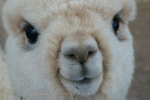Articles by Alpaca World Magazine:
Letter from Germany
Dominic Mueller, Tierra Helada Alpakas
The German alpaca Breed Organisation (AZVD), the biggest of three alpaca associations in Germany, is planning to change its registry substantially in 2007. It hopes to institute a new registration system consisting of a basic registry, a herdbook and a breedbook.
In the basic registry any alpaca may be registered at minimal cost irrespective of its qualities. In the herdbook only those alpacas will be registered that pass a strict screening test. The breedbook is reserved for those sires and dams that accumulate enough points through the screening of their progeny to be elevated to the various levels of the breedbook hierarchy ranging from bronze class to the champions league.
With this registration system, Germany will travel on an innovative but untested alpaca highway. While most registries around the globe accept for registration offspring of already registered sires and dams, the AZVD will only permit those offspring to get into the herdbook that pass a comprehensive and expensive (€80) screening protocol consisting of phenotypical and fibre criteria plus a veterinary examination. The points achieved through this screening process will determine into which category an alpaca will fall: will it be classified as a “pet animal” deemed unfit for reproduction, as an alpaca with limited breeding qualifications, or as a breed animal without restrictions.
The proposed phenotypical examination developed with the help of Eric Hoffman of the US is a refined version of its ARI predecessor. The fibre criteria consist of the following fibre measurements: fibre diameter (AFD), standard deviation (SD), fibre over 30 micron, density and curvature. The veterinary exam is again modelled after the old ARI criteria where a candidate either passes or fails. The point system of 100 points is equally divided: 50 points for the phenotypical criteria and 50 for fibre. An alpaca accumulating 80 points or more is admitted into the herdbook as breeding quality. Those that achieve between 70 and 79 points (of which a minimum 25 points have to come from the fibre component) qualify as breeding stock with limitations. And those that do not get the required points of this category fall into the class of “pet animals” considered unfit for breeding.
Proponents of this new system say it will be a fair, objective and quantifiable way of assessing alpacas, that it takes the guesswork out of raising them by giving clear guidelines and assisting the impressionable newcomer in purchasing breeding stock of identifiable objective qualities.
Opponents counter that it is bureaucratic, cumbersome and elitist leading to a mass exodus of those members, whose breeding stock is of average or below average quality, thus reducing the associations membership and making the AZVD an elitist breeding club for a few powerful breeders.
The pros and cons of this new registration system is the “talk of the town”. The membership of the AZVD will decide in early March of 2007 whether to approve it as proposed or have the necessary changes made to make it more “user friendly” or to reject it outright. Will the exclusive or the inclusive mentality prevail? Time will tell. By the time the 4th annual AZVD Alpaca show in Kreuth, Bavaria, rolls around March 25, 2007 the dust most likely will have settled.
Tweet



